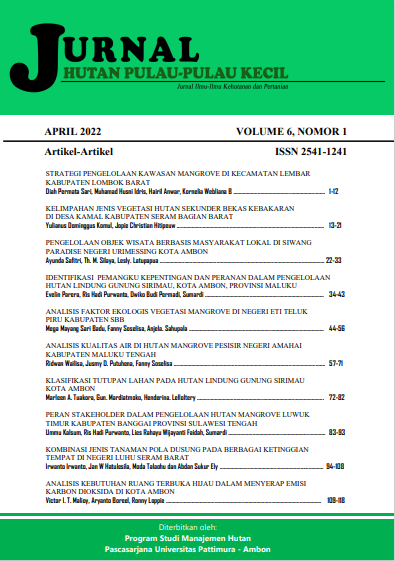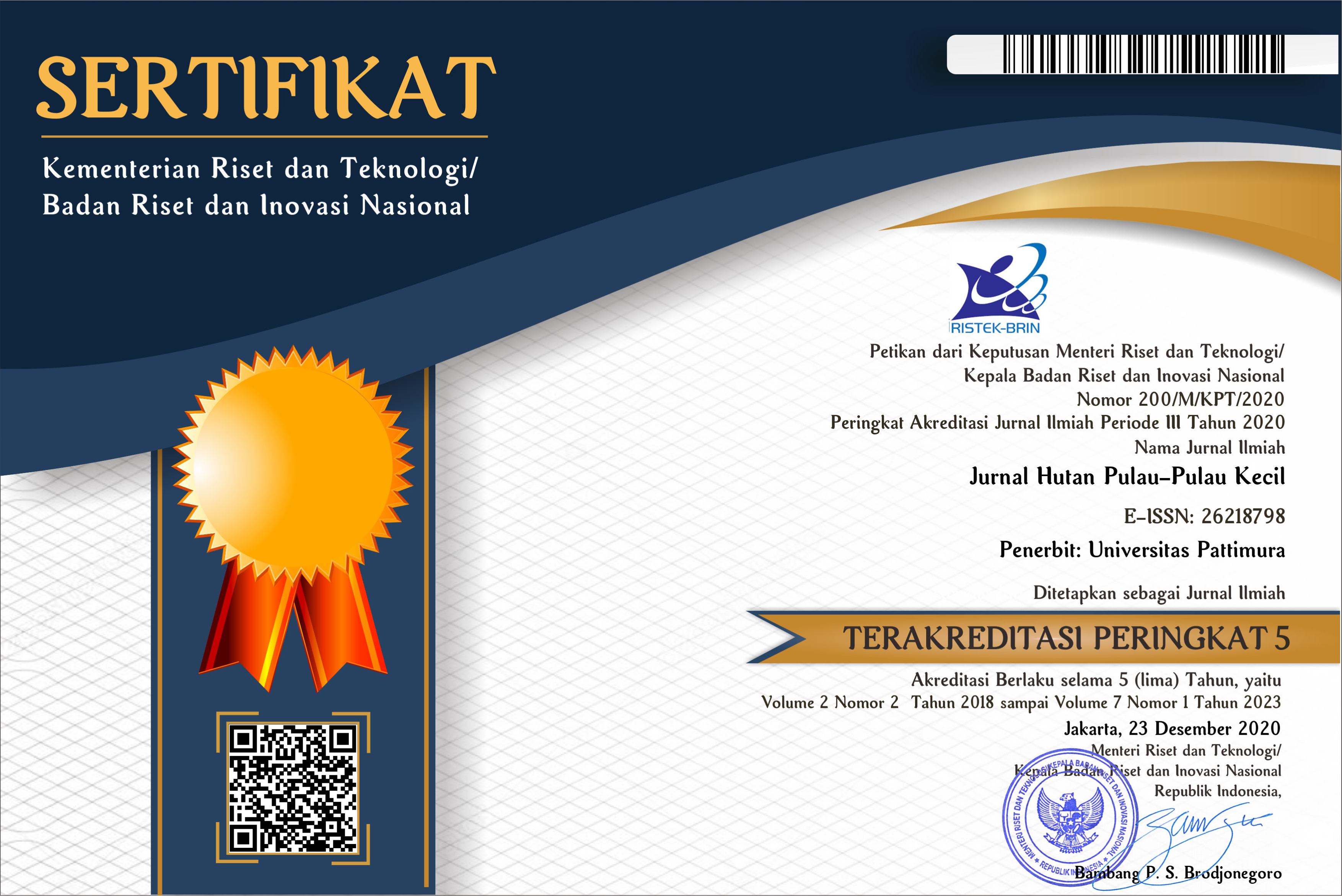IDENTIFIKASI PEMANGKU KEPENTINGAN DAN PERANAN DALAM PENGELOLAAN HUTAN LINDUNG GUNUNG SIRIMAU, KOTA AMBON, PROVINSI MALUKU
Abstract
Protected forest management is the responsibility of all stakeholders related to it. This study aims to identify stakeholders and their roles in protected forest management. The research was conducted in the Mount Sirimau Protection Forest Group, Maluku Province. Collecting data using questionnaires, in-depth interviews, observation and secondary data. Purposive sampling for agencies that have the main tasks and functions and the snow ball method for other stakeholders involved in protected forest management. Data analysis is descriptive qualitative. The results of the identification found the Technical Implementation Unit of the Ambon Island Forest Management Unit and the Lease Islands. Management of protected forests on Ambon Island is intervened by agencies and Technical Implementing Units within the scope of Forestry according to their main duties and functions. Other contributing stakeholders such as Community Social Institutions, Community Organizations, Religious Organizations, Academics, Agencies outside the scope of Forestry such as Public Works and People's Settlements in the Spatial Sector. The role of stakeholders as managers, intervenors, facilitators, participants, evaluators, expert teams, forest resource users and spatial planners.
Downloads
References
Ackermann, F., & Eden, C. (2011). Strategic Management of Stakeholders: Theory and Practice. Long Range Planning, 44(3),179–196. https://doi.org/10.1016/j.lrp.2010.08. 001.
Albert, C., Bonn, A., Burkhard, B., Daube, S., Dietrich, K., Engels, B., Frommer, J., G¨otzl, M., Grˆet-Regamey, A., Job-Hoben, B., Koellner, T., Marzelli, S., Moning, C., Müller, F., Rabe, S.-E., Ring, I., Schwaiger, E., Schweppe-Kraft, B., Wüstemann, H. (2016). Towards a national set of ecosystem services indicators: Insights from Germany. Ecol. Ind. 61 (1), 38–48. https://doi.org/10.1016/j.ecolind.2015.08.050.
Berb´es-Bl´azquez, M., Gonz´alez, J.A., Pascual, U. (2016). Towards an ecosystem services approach that addresses social power relations. Curr. Opin. Environ. Sustainability 19, 134–143. https://doi.org/ 10.1016/j.cosust. 2016.02.003.
Burkhard, B., Kandziora, M., Hou, Y., Müller, F. (2014). Ecosystem service potentials, flows and demands – concepts for spatial localisation. Indication Quantif. 34 (1), 1–32. https://doi.org /10.3097 /LO.201434.
Daniel, T.C., Muhar, A., Arnberger, A., Aznar, O., Boyd, J.W., Chan, K.M.A., Costanza, R., Elmqvist, T., Flint, C.G., Gobster, P.H., Grˆet-Regamey, A., Lave, R., Muhar, S., Penker, M., Ribe, R.G., Schauppenlehner, T., Sikor, T., Soloviy, I., Spierenburg, M., Taczanowska, K., Tam, J., von der Dunk, A., (2012). Contributions of cultural services to the ecosystem services agenda. PNAS 109 (23), 8812–8819. https://doi.org/ 10.1073/ pnas.1114773109.
Díaz, S., Pascual, U., Stenseke, M., Martín-L´opez, B., Watson, R.T., Moln´ar, Z., Hill, R., Chan, K.M.A., Baste, I.B., Brauman, K.A., Polasky, S., Church, A., Lonsdale, M., Larigauderie, A., Leadley, P.W., van Oudenhoven, A.P.E., van der Plaat, F., Schr¨oter, M., Lavorel, S., Aumeeruddy-Thomas, Y., Bukvareva, E., Davies, K., Demissew, S., Erpul, G., Failler, P., Guerra, C.A., Hewitt, C.L., Keune, H., Lindley, S., Shirayama, Y. (2018). Assessing nature’s contributions to people. Science 359 (6373), 270–272. https:// doi.org/ 10.1126/ science. aap8826.
Fischer, A., Eastwood, A. (2016). Coproduction of ecosystem services as human–nature interactions—an analytical framework. Land Use Policy. 52, 41–50. https://doi.org/ 10.1016/j.landusepol. 2015.12.004.
Gissi, E., Garramone, V. (2018). Learning on ecosystem services co-production in decision- making from role-playing simulation: comparative analysis from Southeast Europe. Ecosyst. Serv. 34, 228–253. https://doi.org/10.1016/j.ecoser. 2018 .03.025.
Huntsinger, L., Oviedo, J.L. (2014). Ecosystem services are social–ecological services in a traditional pastoral system: the case of California’s Mediterranean rangelands. Ecol. Soc. 19 (1), 8. https:// doi.org/10.5751/ES-06143-190108.
Jericó-Daminello, C., Schröter, B., Mancilla Garcia, M., & Albert, C. (2021). Exploring perceptions of stakeholder roles in ecosystem services coproduction. Ecosystem Services, 51(August). https:// doi.org/10.1016/ j.ecoser.2021.101353 Khatun.
Loft, L., Mann, C., Hansjürgens, B. (2015). Challenges in ecosystem services governance: multi-levels, multi-actors, multi-rationalities. Ecosyst. Serv. 16, 150–157. https:// doi.org/10.1016/ j.ecoser.2015.11.002.
Mulyaningrum, Kartodihardjo, H., Jaya I. N. S., Bramasto, N. (2013). Stakeholders Analysis of Policy-Making Process : The Case of Timber Legality Policy on Private. JMHT, XIX(August), 156–162. https://doi.org/10.7226/jtfm.19. 2.156.
Nurfatriani, F., Darusman, D., Nurrochmat, D. R., & Yustika, A. E. (2015). Analisis Pemangku Kepentingan dalam Transformasi Kebijakan Fiskal Hijau (Stakeholder Analysis in Green Fiscal Policy Transformation). Jurnal Analisis Kebijakan Kehutanan, 12 (2), 105–124.
Opdam, P., Albert, C., Fürst, C., Grˆet-Regamey, A., Kleemann, J., Parker, D., La Rosa, D., Schmidt, K., Villamor, G.B., Walz, A., (2015). Ecosystem services for connecting actors – lessons from a symposium. Change Adapt. Socio-Ecol. Syst. 2 (1), 1–7. https://doi. org/10.1515/cass-2015-0001.
Overseas Development Administration [ODA]. (1995). Guidance Note on how to Do Stakeholder Analysis of Aid Projects and Programmes. Overseas Development Administration, Social Development Department, 10 p.
Palomo, I., Felipe-Lucia, María., Bennett, E., Martín-López, Berta., Pascual, U. (2016). Disentangling the Pathways and Effects of Ecosystem Service Co-Production. Advances in Ecological Research. Vol. 54. https://doi.org/10.1016/bs.aecr.2015.09.003.
Prell, C., Klaus, H., & Reed, M. S. (2013). Stakeholder analysis and social network analysis in natural resource management Stakeholder Analysis and Social Network Analysis in Natural Resource Management. May 2016. https://doi.org/10.1080/08941920802199202.
Puspitojati, T., Darusman, D., Tarumingkeng, R. C., & Purnama, B. (2012). Pemangku Kepentingan yang Perlu Diberdayakan dalam Pengelolaan Hutan Produksi : Studi Kasus di Kesatuan Pemangkuan Hutan Bogor. Jurnal Analisis Kebijakan Kehutanan, 9(3), 190–204.
Raymond, C.M., Giusti, M., Barthel, S. (2017). An embodied perspective on the co- production of cultural ecosystem services: toward embodied ecosystems. J. Environ. Plann. Manage. 61 (5-6), 778–799. https://doi.org/10.1080/ 09640568.2017.1312300.
Reed, M. S., Graves, A., Dandy, N., Posthumus, H., Hubacek, K., Morris, J., Prell, C., Quinn, C. H., & Stringer, L. C. (2009). Who’ s in and why ? A typology of stakeholder analysis methods for natural resource management. Journal of Environmental Management, 90 (5), 1933–1949. https://doi.org/10.1016/j. jenvman.2009.01.001.
Rova, S., Pravoni, F. (2017). Analysis and management of multiple ecosystem services within a social-ecological context. Ecol. Ind. 72, 436–443. https://doi.org/10.1016/ j.ecolind.2016. 07.050.
Sugiyono. (2017). Metode Penelitian Kuantitatif, Kualitatif, dan R&D. Alfabeta, CV. Bandung.
Spangenberg, J.H., G¨org, C., Truong, D.T., Tekken, V., Bustamante, J.V., Settele, J., (2014). Provision of ecosystem services is determined by human agency, not ecosystem functions. Four case studies. Int. J. Biodivers. Sci., Ecosyst. Serv. Manag. 10 (1), 40–53. https://doi.org/10.1080/ 21513732.2014.884166.
Syahputra, H. O. K., Nugroho, B., Hartodihardjo, H., & Santoso, N. (2018). Stakeholder analysis in community based mangrove management: Case of forest management unit in region 3 of Aceh province. Jurnal Manajemen Hutan Tropika, 24(3), 152–161. https://doi.org/10.7226/jtfm.24.3.152.
UK National Ecosystem Assessment [UK NEA]. (2011). Ecosystem Service. http://uknea. unep-wcmc.org/ EcosystemAssessment Concepts/EcosystemServices/tabid/103/Default.aspx (diakses 14 Januari 2022)
Von Haaren, C., Albert, C., Barkmann, J., de Groot, R.S., Spangenberg, J.H., Schr¨oter- Schlaack, C., Hansjürgens, B., (2014). From explanation to application: introducing a practice-oriented ecosystem services evaluation (PRESET) model adapted to the context of landscape planning and management. Landscape Ecol. 29 (8), 1335–1346. https:// doi.org/10.1007/s10980-014-0084.
Wakka, A. K., Awang, S. A., Purwanto, R. H., and Poedjirahajoe, E. (2014). Analisis Stakeholder Pengelolaan Taman Nasional Bantimurung Bulusaraung, Provinsi Sulawesi Selatan. Jurnal Manusia dan Lingkungan 20(1):11–21. DOI:10.22146 /jml.18470




